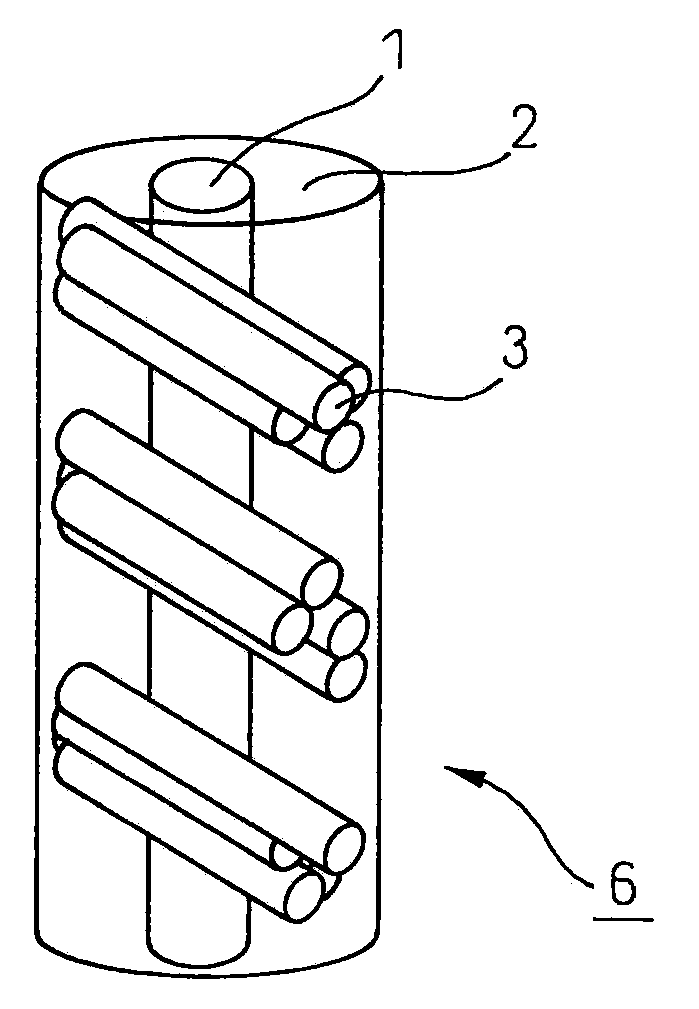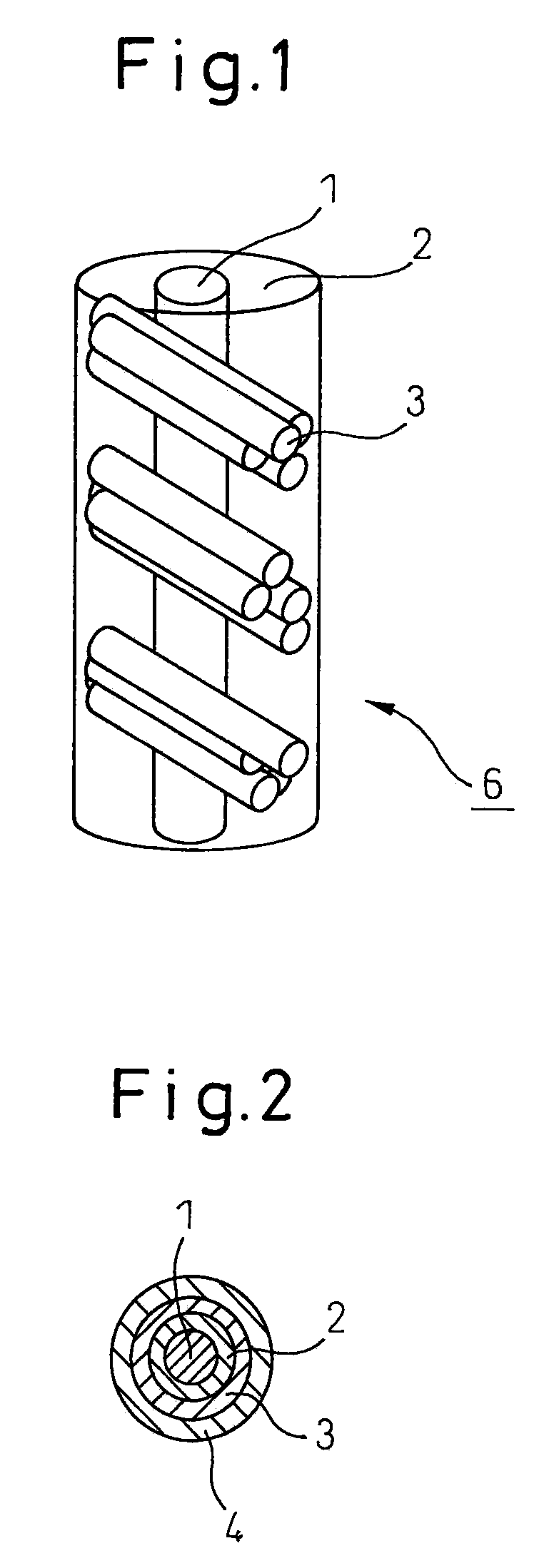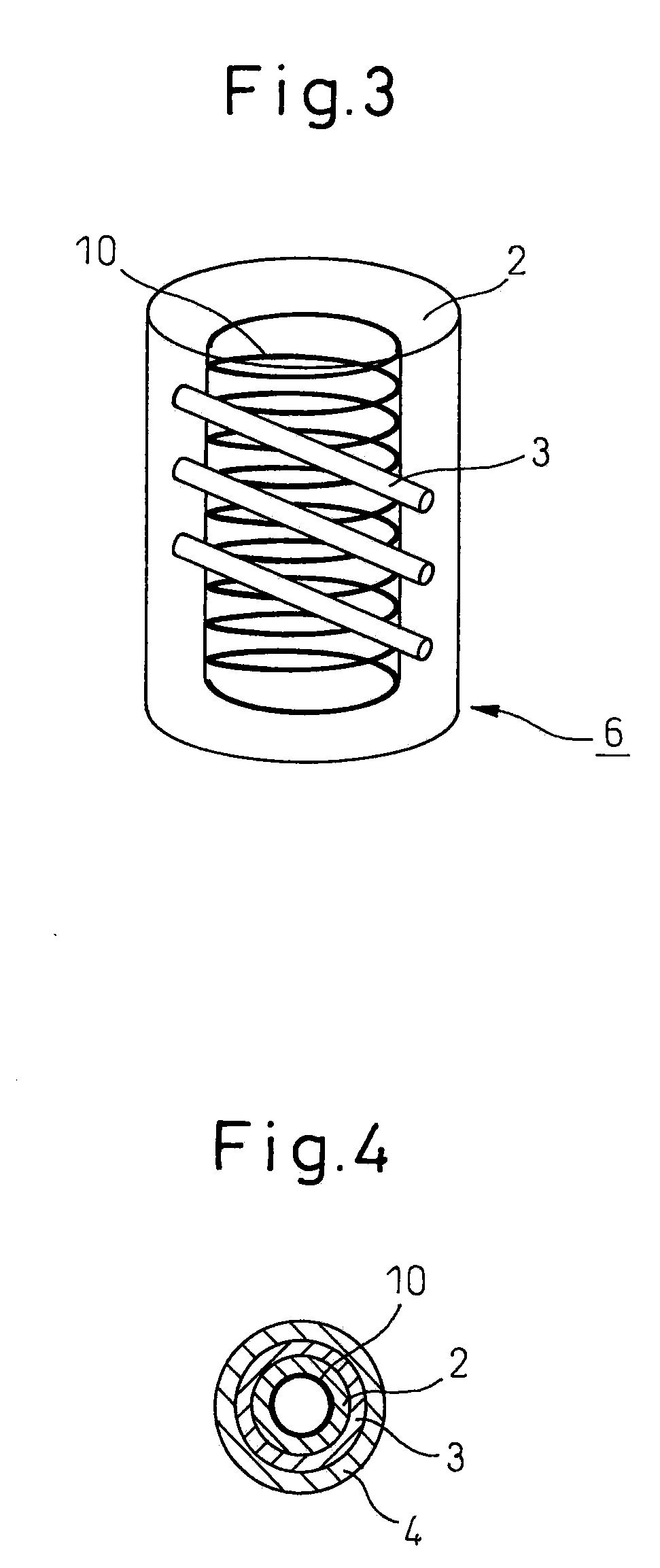Expandable electric cord and production method thereof
a technology of expandable electric cords and production methods, applied in the direction of insulated conductors, cables, conductors, etc., can solve the problems of preventing the obtaining of satisfactory expandable cords, low electrical resistance, and typical thickness and heavy, and achieve the effect of large curren
- Summary
- Abstract
- Description
- Claims
- Application Information
AI Technical Summary
Benefits of technology
Problems solved by technology
Method used
Image
Examples
examples
[0158]Although the following provides an explanation of the present invention based on examples and comparative examples thereof, the present invention is not limited to only these examples.
[0159]The evaluation methods used in the present invention are as described below.
[0160](1) Determination of Elastic Long Fiber Converted Diameter Ld and Conductor Wire Converted Diameter Lm:
[0161]Converted diameter refers to the diameter in the case of viewing the relevant fiber or conductor wire in question as a single cylinder.
[0162]Furthermore, diameter and thickness as treated in the present invention were values obtained in the state of having removed all tension.
[0163]Elastic long fiber converted diameter Ld (mm):
Ld=2×10(mm / cm)×√(D / (d×π×1000000(cm)))=2×(√(D / d×π)) / 100[0164]D: Fiber fineness of elastic long fiber (dtex)[0165]d: Specific gravity of elastic long fiber (g / cm3)
[0166]Furthermore, the outer diameter Ld of a coil spring is measured with a caliper.
[0167]Conductor wire converted diam...
examples 1 to 4
[0227]220 dt (72 f) wooly nylon (black dyed yarn) (Toray Industries, Inc.) was coiled around a core consisting of 3740 dt (288 f) polyurethane elastic long fiber (Asahi Kasei Fibers Corp. trade name: Roica) using a 500 T / M first twist and 332 T / M final twist at a stretch factor of 4.2 to obtain a double-covered yarn. The resulting double-covered yarn was then used as a core to carry out braiding using a composite thread consisting of two aligned strands of the aforementioned wooly nylon with an 8-braid or 16-braid braiding machine (Kokubun & Co., Ltd.) at a stretch factor of 3.2 to obtain an elastic cylinder having an expandable intermediate layer.
[0228]A prescribed copper narrow wire stranded wire (conductor wire) was coiled in the Z direction around the resulting elastic cylinder serving as a core at a stretch factor of 2.6 and feeding speed of 3 m / min using a Kataoka covering machine to obtain an expandable electric cord intermediate.
[0229]Next, using the resulting expandable ele...
example 6
[0237]A prescribed drawn wire was coiled using the SH-7 Coiling Machine (Orii & Mec Corp.) followed by heat-treating by tempering at 270° C. for 20 minutes and then cooling to obtain a prescribed coil spring. Using this coil spring as a core, braiding was carried out using a 440 dt (50 f) fluorine fiber (Toyo Polymer Co., Ltd.) with a braiding machine at a stretch factor of 2.4 to obtain an expandable elastic cylinder.
[0238]Using the resulting elastic cylinder as a core, a prescribed copper narrow wire stranded wire (conductor wire) was coiled in the Z direction at a feeding speed of 3 m / min at a stretch factor of 2.2 using a Kataoka covering machine to obtain an expandable electric cord intermediate.
[0239]Next, using the resulting expandable electric cord intermediate for the core, braiding was carried out with a 16-braid braiding machine using the composite thread consisting of the two aligned strands of 330 dt (72 f) ester wooly yarn at a stretch factor of 2 to obtain an expandab...
PUM
| Property | Measurement | Unit |
|---|---|---|
| Fraction | aaaaa | aaaaa |
| Fraction | aaaaa | aaaaa |
| Fraction | aaaaa | aaaaa |
Abstract
Description
Claims
Application Information
 Login to View More
Login to View More - R&D
- Intellectual Property
- Life Sciences
- Materials
- Tech Scout
- Unparalleled Data Quality
- Higher Quality Content
- 60% Fewer Hallucinations
Browse by: Latest US Patents, China's latest patents, Technical Efficacy Thesaurus, Application Domain, Technology Topic, Popular Technical Reports.
© 2025 PatSnap. All rights reserved.Legal|Privacy policy|Modern Slavery Act Transparency Statement|Sitemap|About US| Contact US: help@patsnap.com



